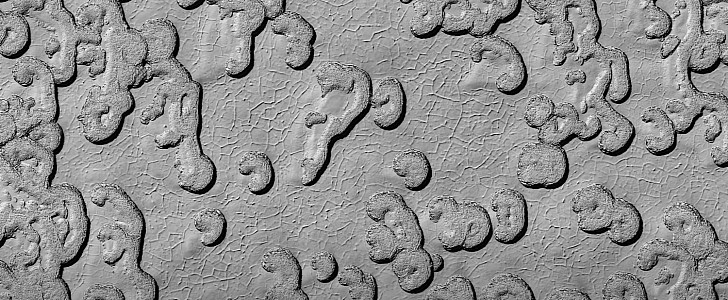A quick look at the main photo of this piece might have you thinking you’re looking at some type of cell culture growing on a Petri dish, as seen through the magical power of a microscope. Yet you’re looking at a sizeable chunk of the surface of Mars, as seen from orbit.
There’s a three-minute or so video beneath this text that gives an even more comprehensive look at these “weirdly wonderful” features. The images were shot with the High-Resolution Imaging Science Experiment camera (HiRISE) of the Mars Reconnaissance Orbiter (MRO), a satellite that has been circling the Red Planet since 2006.
The terrain we’re looking at is an area 5 km (3 miles) across in the southern polar region, as seen from 243 km (151 miles) above the surface. The formations shown are known as Swiss cheese terrain, and unlike what your eyes might be telling you, they are not bulging above the planet, but are actually pits.
According to the University of Arizona, one of the groups responsible for the MRO, these pits are created as a result of carbon dioxide ice erosion caused “by warming of the ground in certain areas.”
According to NASA, these features form when carbon dioxide ice is broken up by a phenomenon called sublimation, which is when something goes directly from solid to gas phase, skipping the liquid state.
Scientists have been looking at these formations for a long time now, “tracking the changes over time” in a bid to better understand polar cap growth and decay. To date, it has been found that the orbiter’s camera can witness a few meters of change in one year.
The video posted last week shows the most recent images captured by HiRISE, but we are not being given any info on when exactly they were shot.
The terrain we’re looking at is an area 5 km (3 miles) across in the southern polar region, as seen from 243 km (151 miles) above the surface. The formations shown are known as Swiss cheese terrain, and unlike what your eyes might be telling you, they are not bulging above the planet, but are actually pits.
According to the University of Arizona, one of the groups responsible for the MRO, these pits are created as a result of carbon dioxide ice erosion caused “by warming of the ground in certain areas.”
According to NASA, these features form when carbon dioxide ice is broken up by a phenomenon called sublimation, which is when something goes directly from solid to gas phase, skipping the liquid state.
Scientists have been looking at these formations for a long time now, “tracking the changes over time” in a bid to better understand polar cap growth and decay. To date, it has been found that the orbiter’s camera can witness a few meters of change in one year.
The video posted last week shows the most recent images captured by HiRISE, but we are not being given any info on when exactly they were shot.


